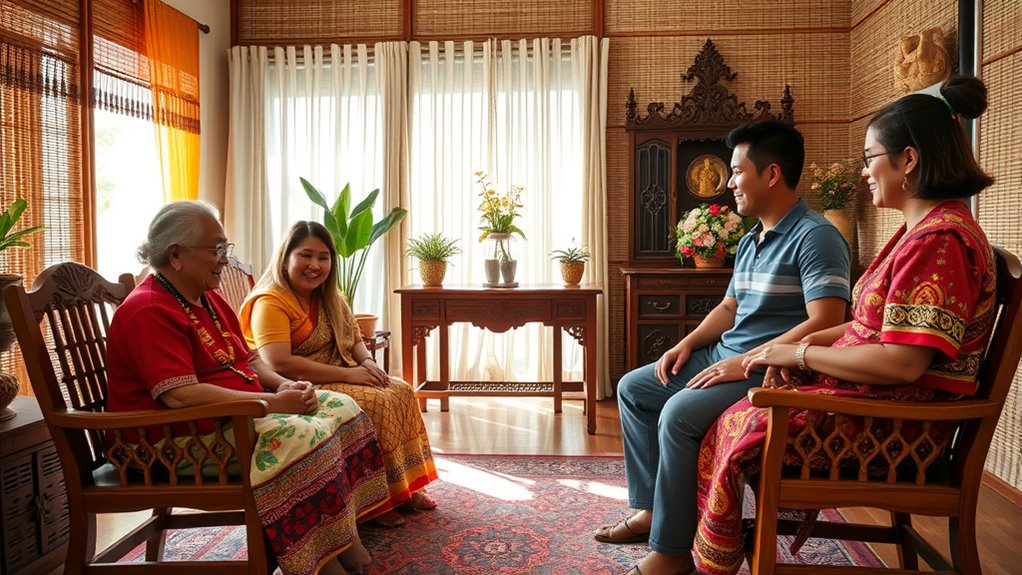Pamamanhikan visits in 2025 are still considered meaningful in Filipino culture, though the way they’re done has evolved. Many families prefer in-person visits for sincerity and emotional connection, but virtual meetings via video calls have become increasingly popular, especially with distant relatives. The core purpose remains: showing respect, gaining approval, and strengthening family ties. Whether in person or online, the tradition continues to adapt while preserving its importance—if you want to know more, keep exploring these changes.
Key Takeaways
- Traditional in-person pamamanhikan remains preferred for respect and genuine family connection, but virtual alternatives are increasingly accepted.
- Modern practices include virtual meetings via video calls, especially for overseas or distant relatives.
- The core purpose—seeking blessing and reinforcing family ties—still makes pamamanhikan relevant in 2025.
- Flexibility in format, such as casual meetups or themed visits, reflects evolving Filipino cultural norms.
- Technology enhances accessibility and emotional connection, ensuring the tradition persists regardless of physical presence.

As the tradition of pamamanhikan continues to evolve in 2025, families are finding new ways to strengthen bonds and honor Filipino customs. While the core purpose remains the same—to formally seek the blessing and approval of the bride’s family before marriage—the way this tradition unfolds has adapted to modern times. The cultural significance of pamamanhikan endures because it symbolizes respect, unity, and the forging of family ties. Yet, today’s approaches reflect a blend of tradition and innovation, accommodating busy schedules and technological advances.
In many cases, families still prefer the traditional face-to-face visit, viewing it as a respectful gesture that upholds the cultural significance of the custom. However, modern adaptations have emerged to make the process more accessible and less burdensome. For instance, couples might arrange virtual pamamanhikan via video calls, especially when geographical distances or pandemic precautions make in-person visits challenging. These virtual meetings retain the essence of seeking approval and sharing intentions but adapt to contemporary lifestyles.
Despite these modern methods, the importance of personal interaction remains strong. Many families feel that physical presence helps foster genuine connection better than digital conversations. When you visit in person, you can observe body language, share a meal, and engage in heartfelt conversations that deepen mutual understanding. Even so, the digital shift guarantees that the tradition remains relevant, especially for those with tight schedules or overseas relatives.
Another modern adaptation involves incorporating elements from contemporary Filipino culture, such as casual gatherings or themed visits, which still respect the core values of pamamanhikan. Some families opt for informal meetups at restaurants or homes, where the emphasis is on open dialogue and warmth rather than formality. These modifications demonstrate how the cultural significance of the tradition persists, even as it evolves to fit the realities of modern Filipino life.
Furthermore, the use of high-speed internet and mobile technology has made virtual pamamanhikan more seamless and engaging, ensuring that distance does not diminish the emotional connection between families. Ultimately, whether through traditional visits or virtual meetings, the essence of pamamanhikan in 2025 lies in the respect and love shared between families. While the methods may change, the spirit of the custom—seeking blessing, fostering unity, and honoring family—remains intact. You can see that, despite shifts in approach, the tradition continues to serve as a meaningful bridge that ties generations together, reinforcing the importance of kinship and Filipino values in today’s world.
Frequently Asked Questions
How Has the Cultural Significance of Pamamanhikan Evolved Recently?
You might notice that pamamanhikan’s cultural significance has evolved due to generational shifts, blending traditional values with modern perspectives. While it once symbolized formal family approval, today’s approach emphasizes open communication and mutual understanding. Despite these changes, many still see it as a essential part of cultural preservation, maintaining respect for elders and reinforcing family bonds. So, it remains relevant, adapting to contemporary relationships while honoring tradition.
Are There Regional Differences in How Pamamanhikan Is Conducted Today?
You’ll find that regional variations influence how pamamanhikan is conducted today. In some areas, it’s still a formal event where families meet to discuss the upcoming union, while others have embraced cultural adaptations, making it more casual or skipped altogether. These differences reflect local customs and evolving traditions. Overall, the core purpose remains, but the way it’s practiced varies, showing how culture adapts across regions.
What Modern Alternatives Exist if Families Choose Not to Do Pamamanhikan?
Like a bridge connecting past and present, modern practices adapt cultural traditions. If you and your family prefer to skip traditional pamamanhikan visits, you can opt for virtual meetings or casual gatherings that still honor your roots. These alternatives reflect cultural adaptation, making the process more convenient while maintaining respect and connection. Embracing modern methods guarantees you uphold family values without the formalities of traditional visits.
How Do Younger Generations View the Tradition of Pamamanhikan?
You might notice that younger generations view pamamanhikan through a lens of modern perceptions shaped by generational shifts. Many see it as a meaningful tradition, but some consider it outdated or unnecessary in today’s more casual approach to relationships. While many still value the cultural significance, others prefer to skip the formal visit, opting for simpler, more personal conversations about marriage plans.
Are There Legal or Official Requirements for Pamamanhikan in Marriage Processes?
Legal requirements and official procedures don’t mandate pamamanhikan visits in marriage processes today. You’re not legally obliged to conduct these visits, as they’re more cultural than legal. While some families still value this tradition, it’s usually a matter of personal or family preference rather than an official requirement. So, you can choose to observe or skip pamamanhikan based on your traditions, without worrying about legal or official obligations.
Conclusion
So, despite all the modern twists and digital updates, you might find yourself still planning that traditional pamamanhikan visit in 2025. Ironically, in a world obsessed with instant connections, it’s those old-school visits that still hold the real weight—and maybe even the secret to a smoother wedding. Who knew that in our tech-heavy age, a simple face-to-face chat could still be the key to sealing the deal? Guess some traditions never go out of style.









